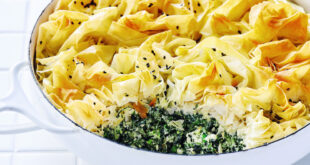Taste Editor Suzanne Dale has some great tips for working with this versatile vegetable.
 Sweet and comforting, kumara is a vegetable that really comes into its own in winter – roasted, baked, microwaved, mashed (it’s a great pie topping), made into soups and fritters or fried as chips. Available year round, it is harvested in Northland from February to April but, before making their way into stores, the vegetable is stored for a few months to allow the wonderful conversion where the starch turns to sugar. Luckily kumara is not only delicious but is good for you too, being one of the top three food sources of potassium. In a 100g serving it offers 63 per cent of our daily recommended potassium intake. It is also very rich in vitamin C, with good amounts of vitamins A and B.
Sweet and comforting, kumara is a vegetable that really comes into its own in winter – roasted, baked, microwaved, mashed (it’s a great pie topping), made into soups and fritters or fried as chips. Available year round, it is harvested in Northland from February to April but, before making their way into stores, the vegetable is stored for a few months to allow the wonderful conversion where the starch turns to sugar. Luckily kumara is not only delicious but is good for you too, being one of the top three food sources of potassium. In a 100g serving it offers 63 per cent of our daily recommended potassium intake. It is also very rich in vitamin C, with good amounts of vitamins A and B.
We grow three main kumara crops in New Zealand: red, gold and orange – the sweetest of the trio. When buying, look for firm kumara that are clean and blemish free with a deep, even skin tone.
Always store kumara in a cool, dry place and remember to treat it kindly. They bruise easily. Refrigerating is another no-no. Storing below 10°C will cause the kumara to develop a woody centre. Conversely, do not to store them where it is too warm. It leads to sprouting. If you need to store kumara for longer periods, try wrapping each one in newspaper.
Quick cooking tips
To bake kumara: prick the skin and cook in a 180°C oven for 45-50 minutes.
To microwave: Prick skin and cook on high, turning each kumara halfway through cooking time, for about 3-4 minutes. Wrap them in foil and rest them for a few minutes before serving.
Top with sour cream and chives or chutney.
Love kumara chips? Try these two ways from Taste food editors Allyson Gofton and Julie Biuso. Allyson’s Tikka Masala Kumara Chips partners kumara’s sweet taste with a spicy curry mix. And Julie’s Kumara Crisps with Salsa and Mayonnaise is great when friends pop over. Or check out more kumara recipes from Taste magazine.










- 11 years ago
ikil